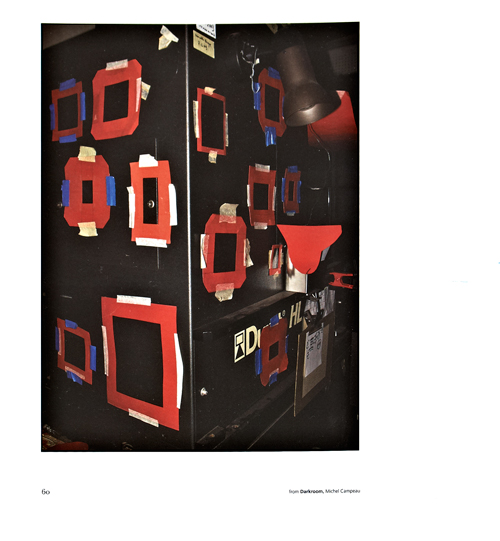| SIMON DENISON IMAGE & TEXT |
| PREVIOUS | NEXT |
MICHEL CAMPEAU: DARKROOM Ffotogallery, Cardiff
The inevitable has happened: the photographic darkroom has now joined that long list of institutions, locations and site types recorded by the camera just as they are swept aside by history. The darkroom has long been mythologised as a place of alchemy and mysterious practices, and Canadian photographer Michel Campeau’s series emphasises the strangeness of it all by focusing on the peculiar tools and materials of darkroom craft: the hand-made dodgers, the negative carriers and masks in assorted shapes and sizes, the clothes pegs, the discarded spools of backing paper, the packed files of negatives, the clipped film ends, the clock-timers, the safety lights, the darkroom coats stained with fixer. His untitled photographs show everything but explain nothing. They will leave anyone without experience of a darkroom – which will be virtually everyone in a few years’ time – little the wiser. Photographers, however, who have mostly only recently left their darkrooms, will inevitably view this work through the emotional prism of their own experiences. Campeau, who is in his 60s, has described the work in terms of bereavement, seeking to invest the darkroom ‘with the connotations of ruin and post-industrial debris’. But brightly lit and close-focused, the work does not have an elegiac style. It is strongly graphic, as all tightly-cropped photographs tend to be, aided by the ramshackle nature of the darkrooms Campeau has chosen to depict. Here we have trailing wires, patterns of coloured tape on walls, mismatched arrangements of lights, bowing worktops, cracked walls, scuffed and overflowing coloured bins. It almost seems churlish to point out that many darkrooms in reality were blander, tidier, places than this; but they would have made less intriguing photographs. There is something of William Eggleston’s colour formalism here, mixed with a hint of Roger Ballen’s psychologically deranged interiors. Campeau’s images are certainly striking as pictures. But do they reveal anything of significance about darkrooms? The depiction of various mysterious objects reveals little in itself; all specialist crafts operate with toolsets that seem indecipherable to the outsider. The mechanic’s domain, or the instrument maker’s, or the bookbinder’s, or the chef’s, would yield similarly graphic mysteries. The makeshift, gaffered-up, scruffy character of Campeau’s selectively chosen darkrooms perhaps suggests a little more: that darkrooms were private spaces, not intended for display, the workshops of (one suspects mostly) men who were – to put a romantic spin on it – too intensely preoccupied with the task at hand, the creation of the great print, to concern themselves with the neatness of their working environments. Yet a definitive body of work about darkrooms, one compiled for the future, might have sought to address the essence of the subject, not just its trappings and paraphernalia; to suggest something of the unique experience of working in a darkroom, of what made its processes and products so different from those that have supplanted them, and why its disappearance matters. Photographer-printers will perhaps not agree exactly what that essence was; but there will surely be strands common to all accounts. The intense concentration necessary when working with a latent image which demanded the closest engagement with every detail of the picture; the patience required, and the tension involved in waiting through long minutes of exposure and development before you saw the result of your work; the unpredictability of handling volatile chemicals and papers, and the consequent agonies of frustration or – conversely – the exultation a printer felt over a successful print: all this is gone with the easy, predictable workflow of computers. The darkroom printer’s experience was physical and multi-sensory, as he or she shaped the enlarger’s light with their hands and tools, intently watching and judging as they slowly rocked trays of chemicals, immersed within the room’s distinctive smells and sounds and its red glow. None of this is meant to idealise the darkroom, or decry its passing; nearly all photographers express nothing but relief that they no longer have to suffer the darkroom’s strains and cruelties. Yet the physicality and unpredictability of the darkroom were fundamental to what made a darkroom print so different from a digital one – in essence if not in superficial appearance. A darkroom print is a unique material object, a variously darkened surface of silver salts shaped with minute precision by hand. It is therefore analogous to a hand-crafted artwork made of any other material in a way that a digital print can never be. An inkjet is one of a potentially infinite number of identical representations of something that has no substance – a set of electronic instructions visualised on a screen. It is summoned into existence by a few taps on a keyboard. The instructions will have been minutely adjusted, of course; but the print itself is not a material that has been shaped by hand. Contemporary photographers keen to sell their inkjets for large sums might insist on the equivalence, or even superiority, of the inkjet’s appearance but they can never quite sidestep the question of ontology. Campeau regards the darkroom as a relic of a vanished industrial age. Papers, films, chemicals were of course made in factories. But the real industrial age is upon us now. The darkroom print was substantially crafted by hand and brush. The inkjet print derives its appearance from the colour-sets and nozzle technologies created in the factories of Epson and Hewlett-Packard. Our scope for shaping a contemporary picture is defined by the programmers of Apple and Adobe. Few of us have a clue how to fix our equipment when it goes wrong. We are entirely in others’ hands. If there is an elegy to be sung over the death of the darkroom, its scope should be broader and deeper than a decoratively graphic portrayal of darkroom odds and ends. |
 |
|---|---|